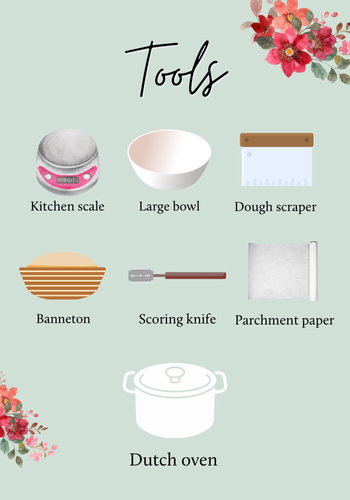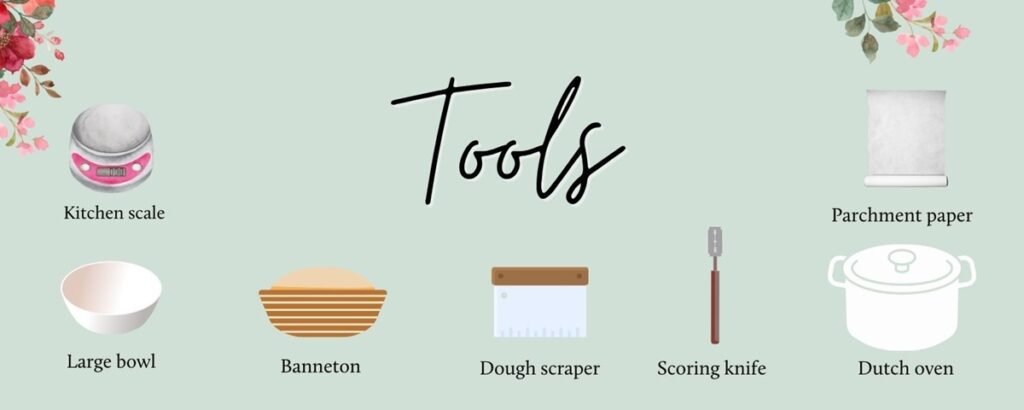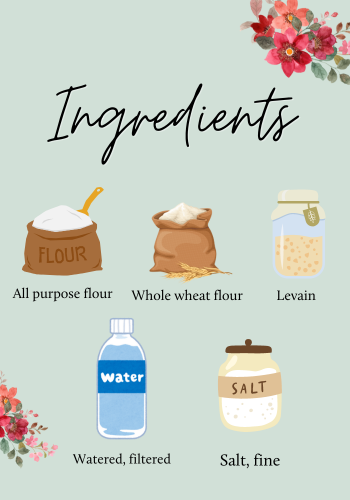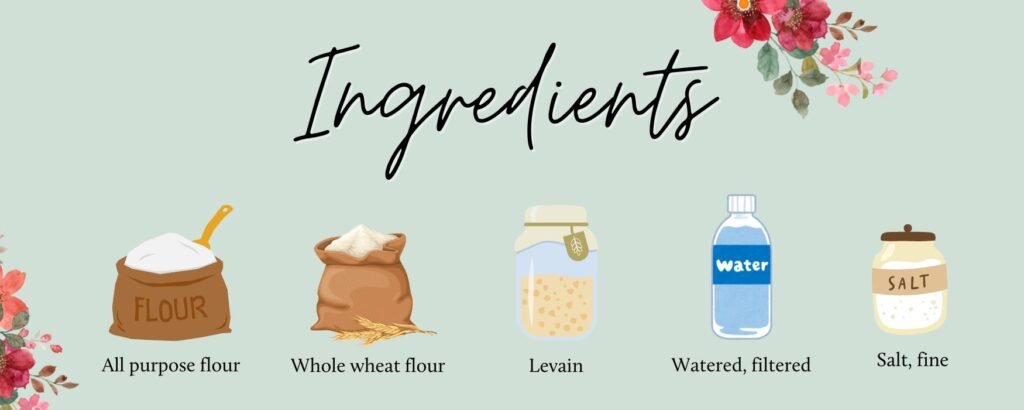This beginner’s and no knead sourdough bread recipe will guarantee you succeed at your first ever made sourdough bread. It is a very friendly recipe that will allow you to understand the basics of the process, and give you the foundations of sourdough bread baking.
Why I love this beginner's sourdough recipe
Easy to shape
Simple ingredients
Simple process
Summary of the Process
More important than following time, is knowing the temperature of the dough (using a thermometer) to take real temperatures. That will give you a better idea on how things are evolving.
As an example – a dough at 70F, will take 40% extra time than what I have in this recipe.
Levain
Mix
Folds
Shape
Bake
Let's Get Ready
Tools needed
- Kitchen digital scale
- Large bowl
- Banneton
- Dough scraper
- Scoring knife
- Dutch oven (5qt at least)
- Parchment paper


Ingredients needed
- All purpose flour (never bleached or bromated)
- Whole wheat flour (never bleached or bromated)
- Water, filtered
- Levain (ripe sourdough starter) – click here to know what a levain is
- Salt, fine
Shop my 8-years old Sourdough Starter


FAQ
Replacing a sourdough starter for commercial yeast is not a straightforward substitution. The sourdough starter is made of flour, water and mother starter, which is different (in weight and form) from the powder texture of commercial yeast.
If you want to start using a sourdough starter you can shop my 8 year old here! There is FREE shipping and comes with video instructions, digital ebook and email support.
Not at all,
please check the tools list provided on this page. If you have any questions dont hesitate to leave a comment below or email contact@vituperio.com
That controlling the temperature of the dough is key! Yeasts will only make your dough rise if the temperature is right for them. So make sure you have a warm spot, or use a dough proofer. I have provided all my favorite tools here.
If your dough is constantly at 85F, it should take you between 4 to 5 hours for the dough to fully rise. After shaping, you will need to place the dough in the refrigerator for 12 hours, max 24 hours.
Every time you are using your sourdough starter to make bread, you need to create a “Levain”.
What does a Levain mean? a Levain is when you use few grams of your mother sourdough starter and combine it with new flour and water.
Then, you need to allow the Levain to rise until it doubles in size. At that moment, it can be used in this sourdough bread recipe.
If you have any additional questions on sourdough starter or would like to learn all about it, please check my online class here.
You don’t need to use filtered water as long as the water where you live is not heavily chlorined. Try to use the same water that you use to feed your starter.
Because we need to be very precise on the ingredients to be able to expect the same results consistently.
You can substitute all purpose flour for bread flour. For this, you will need to adjust the grams of water in the recipe. Add 10 grams extra grams.
This is the only substitution you can make.
Use water at room temperature. Avoid hot water as it might kill your starter.
Use any type of fine salt. It’s easier to mix and blend a fine salt when mixing the dough.
Don’t add a tray with ice or boiling water, as you risk breaking your oven glass door. If you don’t have a dutch use the method I provide here.
Baking Schedule
Have in mind, that I have created these schedules under an 85°F environment (using a dough proofer – check my favorite ones here). I highly recommend taking the temperature of your bread dough throughout the process as it will give you important information on how things are evolving.
Below are 2 possible schedules to make this beginner’s sourdough bread recipe.
Baking Schedule - Option 1
| Time | Step | Summary |
|---|---|---|
| 8pm | Prepare Levain | 12 hours on the day before planning to mix |
| 8:00am - 8:20am | Weigh ingredients and mix dough | Mixing, bulk fermentation, shape |
| 8:20am - 12:20pm | Perform folds every 30/45 minutes | |
| 12:20pm-12:30pm | Divide, pre-shape and bench rest | |
| 12:30pm-12:40pm | Final shape and place into banneton or loaf pan | |
| 12:40pm | Asses if it needs more rising. If it does, add 30 minutes and assess again | |
| 12:40pm | Place in the refrigerator to proof until next day | |
| Next day | Bake | Baking |
Baking Schedule - Option 2
| Time | Step | Summary |
|---|---|---|
| 7:30 am | Prepare levain (use fast rising levain recipe) | 12 hours prior to mixing |
| 12:30pm -12:50pm | Weigh ingredients and mix dough | Mixing, bulk fermentation, shape |
| 12:50pm - 4:50pm | Perform folds every 45 minutes | |
| 4:50pm- 5:00pm | Divide, pre-shape and bench rest | |
| 5:00pm-5:10pm | Final shape and place into banneton or loaf pan | |
| 5:10 pm | Asses if it needs more rising. If it does, add 30 minutes and assess again | |
| 5:10 pm | Place in the refrigerator to proof until next day | |
| Next day | Bake | Baking |
1. Prepare the Levain
Remember that after making the Levain, you will need to let is sit in a warm spot to rise and double in size before being used in this sourdough bread recipe.
Always have in mind...
For that reason, I always use a dough proofer to have a consistent 85°F environment.
OPTION 1
Levain recipe - Slow rise (12 hours)
| Ingredient | Grams | Baker's Math |
|---|---|---|
| All purpose flour | 50 | 100% |
| Water | 50 | 100% |
| Mother sourdough starter | 5 | 10% |
| Total | 105 | 210% |
OPTION 2
Levain recipe - Fast rise (4 hours)
| Ingredient | Grams | Baker's Math |
|---|---|---|
| All purpose flour | 35 | 100% |
| Water | 35 | 100% |
| Mother sourdough starter | 35 | 100% |
| Total | 105 | 300% |
2. Weigh Ingredients & Mix
| Ingredients for 1 loaf | Grams | Baker's Math |
|---|---|---|
| All Purpose Flour | 400 | 80% |
| Whole Wheat Flour | 100 | 20% |
| Water | 350 | 70% |
| Levain | 100 | 20% |
| Salt | 10 | 2% |
| Total Dough | 960 | 192% |
3. Bulk Fermentation
Folds, every 30-45 min
Can you perform folds more often? For example... every 15 minutes?
Why do you need to perform folds?
Production of CO2 and by-products
How does temperature affect bulk fermentation?
However, if the dough is warmer than that (it should never be above 90F) set a timer for 3 hours to assess how much CO2 has been built.
If the dough is colder, you dough will need more than 4 hours to fully rise. Your dough will be ready when it has built the CO2 it needs! If that is 4 hours or 6 hours… that is fine.
Check out how to perform folds on the video below
4. Divide and Shape
During this part of the process you don’t want to lose the CO2 that is trapped inside the dough. For that reason, be very gentle when manipulating it.
When shaping, you don’t need more than few grams of flour. Make sure to check out the video of this recipe so you can see how I shape. If you already added too much flour and the dough is sliding on the counter when shaping, brush it off and using a moist towel, make the dough sticky again.
Don't add too much flour when shaping...
5. Proof (Cold)
Asses if it's risen enough...
Cold proofing
What are the health benefits?
- Has a low glycemic index
- Gluten is easier to digest
- Phytic acid has been broken down
6. Bake
Preheat the oven at 470F
Flip the dough onto parchment, and score
Place the dough and parchment paper inside the preheated dutch oven
Bake with lid on for 20 minutes...
7. Store your Beginner's Sourdough Bread
How to correctly store sourdough bread

Beginner's Sourdough Bread
Equipment
- Digital Scale
- Bowl medium/large size
- Dough Scraper
- Dutch Oven at least 5 QT
- Banetton 8 or 9 inches
- Lame (Scoring Knife)
Ingredients
- 400 grams All Purpose Flour Not bleached or bromated
- 100 grams Whole Wheat Flour Not bleached or bromated
- 350 grams Water, filtered
- 10 grams Fine Salt
- 100 grams Levain Active sourdough starter
- Rice Flour a handful (to cover the banneton)
Instructions
Prepare the levain
- Check the 2 recipes provided for the levain. None is better that the other, it will just depend on your preferred schedule. Then, either 4 or 12 hours before making this recipe, create the levain according to the instructions provided.Let it rise, ideally in a warm spot of 85F.It will be ready to be used in your dough when it has doubled in size.
Weigh ingredients
- Using a kitchen digital scale, weigh the ingredients of the recipe.*Make sure your digital scale is in the correct unit: grams.
Autolyse
- In a large bowl add: water, levain, all purpose flour and whole wheat flour. You will NOT add the salt at this point.Mix thoroughly, until you feel no flour lumps and see no dry spots. Let the dough rest for 30 minutes covered with plastic wrap (or anything to prevent it from creating a skin and getting contaminated by external agents).Instead of hand mixing, you can use your stand mixer with the dough hook.
Add salt
- Once the above 30 min have passed, sprinkle the salt on top. Thoroughly mix the salt. You want to make sure it is evenly distributed.TIP: Fill a bowl with water, and get your hands wet to mix the salt in the dough. This will help the dough from sticking to your hands. Be careful no to add excess water to your dough.
Bulk Fermentation
- Bulk fermentation: fold the dough from edge to center carefully. Perform folds every 30 minutes for 3 to 4 hours. It will depend on the temperature of the dough when this stage finishes. This is the most important part of making sourdough bread, as here is when the dough needs to rise! Not allowing the dough to build enough CO2 inside will result in a flat and dense loaf.
Divide/Shape
- You will only if you do more than 1x this recipe or make smaller size breads.
- Shape the dough:a. If using a banneton –sprinkle rice flour on the liner to prevent the bread from sticking (if you don't have rice flour, just use all purpose). The shaped dough will be placed seam side-up.b. If using a Loaf Pan, grease the loaf pan with oil or butter. The shaped dough will be place seam side-down.
Asses before cold proofing
- If your dough needs to build more CO2 this is the moment!Remember that you can always allow your dough to sit a little longer to rise more. When learning to shape, you might lose C02 when manipulating the dough so this part of the process is very important for beginners.
Cold proofing
- Place the banneton or loaf, covered in plastic wrap, inside the refrigerator for at least 12 hours and maximum 24 hours.
- After cold proofing has been done, the next step is baking the loaf so start by preheating the oven with your Dutch Oven inside at 480°F. Once the oven has reached its temperature, go to the next step.
Bake
- Preheat the oven with your Dutch Oven Inside at 480°F.
- Cut a piece of parchment paper, as you will flip the bread over it.
- Get the dough from the refrigerator and flip over the piece of parchment paper.
- Score: using your scoring knife, gently cut the top of the dough making sure not to puncture too deep.
- Place the bread carefully with the parchment paper inside the Dutch Oven and put the lid on. Bake for 20 minutes. Then, lower the T° to 450°F, take the lid off and bake for another 15-20minutes, or until the crust looks nice and golden.
- Let the bread cool and enjoy!

Thank you, thank you, thank you! I received the starter kit today and look forward to actively jumping into your method. I appreciate your patience with me.
Fondly,
Your Sour Dough Starter problem child.